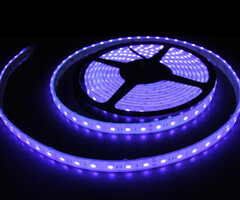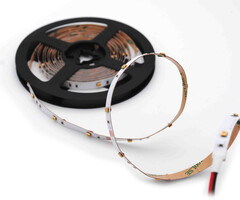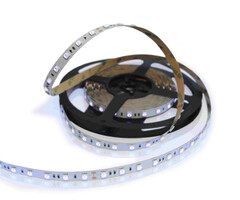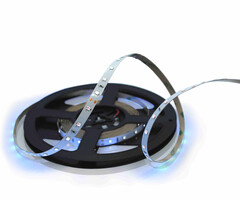
UV LED Strips
Applications for UV LED Strips
A UV or violet LED strip can be used in many ways and is known for its beautiful purple light and fluorescent effect. The subtle violet light can be a wonderful addition to a bar or restaurant, but also at home. The type of violet that can be created with LED lighting cannot be replicated with any other light source: Compared to a traditional TL blacklight tube, a UV LED strip provides much purer light.
Applications for UV LED Strips
A UV or violet LED strip can be used in many ways and is known for its beautiful purple light and fluorescent effect. The subtle violet light can be a wonderful addition to a bar or restaurant, but also at home. The type of violet that can be created with LED lighting cannot be replicated with any other light source: Compared to a traditional TL blacklight tube, a UV LED strip provides much purer light.
We offer several options for UV LED strips. For example, we have waterproof UV LED strips as well as UV LED strips without a protective layer. Additionally, we offer them in different "shades" or wavelengths.
Different Wavelengths of UV LED Strips
Light is electromagnetic radiation. The wavelength of light determines the color we perceive. UV light has a wavelength between 400nm and 100nm. "nm" stands for nanometer and indicates how fast the "vibration" of the light is. The shorter the wavelength (i.e., the lower the nanometers), the faster the vibration and the more energy the radiation contains. This is also why UV radiation with short wavelengths can be harmful, but more on that later. First, some explanation about the term UV: UV stands for ultraviolet. The spectrum of visible light ranges from about 780 to 380nm, so shorter wavelengths are not visible to the eye. The shortest wavelength that the eye can perceive is violet, which has a wavelength of 380-400nm. Light with a shorter wavelength is invisible to the eye. This is then called UV or ultraviolet. "Ultra" because it lies outside the visible spectrum. Often, we also speak of "UV radiation" instead of UV light, as it is invisible. However, both terms mean exactly the same: electromagnetic radiation. When electromagnetic radiation falls within the visible spectrum (780-380nm), we conveniently call it "light," and when it falls outside this range, it is often referred to as "radiation." Hopefully, this doesn’t give you a headache! For convenience, you can remember that only UV above 380nm produces visible violet light, while UV with a wavelength below 380nm emits only invisible UV radiation.
We offer UV LED strips in several wavelengths. Firstly, we have 400nm, this LED strip emits visible violet light. This violet light appears as a subtle purple glow that is just perceptible to the eye. This can create a very beautiful effect when used as accent lighting, for example. The 400nm UV LED strip also still has the fluorescent effect, causing fluorescent objects like white T-shirts, paper, or certain rocks to glow. The next wavelength we offer is 370nm, which lies just outside the visible spectrum, so you can hardly see any light, just a faint blue glow. However, if you hold a bleached piece of paper close, you’ll see a strong fluorescent effect. This LED strip is therefore perfect as a blacklight. When using this LED strip, make sure that a lot of invisible UV radiation is emitted and that no one looks directly into the LEDs. Although you only see a very faint blue light, these LEDs emit a lot of radiation. Place this LED strip in a location where no one can look directly into the LEDs.
Is UV Radiation Harmful?
UV radiation is divided into 3 categories: UV-A (400-315nm), UV-B (315-280nm), and UV-C (280-100nm). You’ve probably seen these terms on a bottle of sunscreen. Sunlight contains a lot of radiation in all these spectra. The wavelengths of 400nm and 370nm we have discussed so far fall into the "UV-A" category, and this wavelength is not harmful. Radiation with a wavelength shorter than 315nm (UV-B or UV-C), however, is dangerous, with 270nm (UV-C) being the most harmful. We also sell UV-C LED strips with a wavelength of approximately 275nm. This type of LED strip is often used in industrial or medical applications, for example, for disinfection. Before ordering this type of LED strip, please ensure you can use it safely: This LED strip is harmful to skin and eyes. If you order this LED strip, we will always contact you beforehand to discuss its use.
Which Wavelength Should I Choose?
If you’re looking for a nice pure violet light for accent lighting and want to clearly see the light, with the fluorescent effect being less important, choose 400nm. This type of LED strip is perfect for accent lighting in hospitality settings, as well as unique lighting at home, in public spaces, on vehicles, and anywhere else you’d like to use this distinctive light color. Are you specifically looking for the fluorescent effect? Then use 370nm. However, ensure it is used safely, and people are not tempted to look directly into the LEDs from up close: this can be harmful to the eyes. The 370nm wavelength is visible as a very faint blue glow, but it is almost invisible. However, the amount of UV radiation remains very high, so the fluorescent effect is strong!
If you are a professional in the medical industry, conducting research at, for example, a university, or have another very specific application for UV radiation and are aware of the dangers and functionality of UV radiation, you can use 275nm.
Waterproofing
We often offer our LED strips in 2 types: Non-waterproof or fully waterproof (IP68). A non-waterproof LED strip is completely unprotected, and you can directly touch the LEDs on the strip. With IP68, the LED strip is fully encased in silicone, making it completely waterproof and even suitable for underwater use. If you want to solder waterproof LED strips, you need to remove the silicone layer before soldering the wires to the soldering points. This means that the LED strip is no longer waterproof at that point. After soldering, you need to make the LED strip waterproof again. For this, we offer end caps and silicone glue, which you can find under related products with the LED strips. Non-waterproof LED strips are suitable for indoor spaces with little to no moisture or high humidity. For all other applications, we recommend waterproof LED strips.
Wattage and Number of LEDs per Meter
When comparing the light output of two LED strips, the different specifications can be confusing. A general rule of thumb you can use is to only look at the wattage. An LED strip may use different LEDs that are, for example, brighter or dimmer, so the number of LEDs per meter doesn’t tell the whole story. By comparing only the wattage of two LED strips, you can get a good idea of the light output. For more information on comparing different LED strips, we recommend checking out our information page on comparing different LED strips.
Connecting LED Strips to a Power Adapter
The LED strips on this page all operate on 12 or 24 Volts. This means you’ll also need a transformer to connect them to 230V. The transformer (also called a power adapter) is chosen based on the wattage of the LED strip. For example, if you want to connect 30 watts of LED strip, you’ll need a power adapter with at least 30 watts. If you want to connect 10 meters of LED strip at 12 watts per meter, the adapter needs to be at least 120 watts. You can always choose a slightly higher-powered adapter than required, as it will never supply more power than needed. For more information on this and to order the transformer, we recommend visiting the category page Power Supplies.






